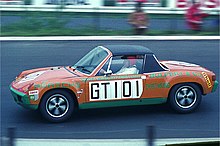Gran Turismo
Gran Turismo (Italian), English Grand Touring , French Grand Tourisme - GT for shortand loosely translated "big trip" (see Grand Tour ) - describes the purpose of original GT vehicles, i.e. relatively comfortable and well-motorized sports cars suitable for long-distance races are.
Original GT vehicles
GT vehicles in the original sense differed from the Spartan pure sports cars in that they are more comfortable, have a larger interior space and are more suitable for traveling comfortably over long distances.
Such vehicles were used with a co-driver ("lubricant") in long-distance races, especially in the Italian classics Targa Florio and Mille Miglia , in which from 1927 to 1957 up to 1600 kilometers were driven across Italy on public roads , similar to the Carrera Panamericana in Mexico. The co-driver was soon dispensed with on closed racetracks, as he was hardly useful as a mechanic or navigator . A typical field of activity for GT vehicles has been 24-hour races , for example at Le Mans , Daytona or the Nürburgring and at 1000 km races ( Nürburgring , Monza or Spa-Francorchamps ).
After the war, the epitome of thoroughbred GT vehicles became the Ferrari models from the 1950s to 1970s that included GT in the type designations, such as the 250 GT , 250 GTO or 365 GTB . But different Lancia models such as the Aurelia or Fulvia can also be mentioned here alongside some Alfa Romeo and Maserati . The English Bentley dominated Le Mans at times; later Jaguar and Aston Martin built typical GT vehicles. Mercedes had already brought out a GT offshoot of the luxury sedans in the late 1920s, the SSK. After the war, the largest available engine, the six-cylinder from the 300 sedan, was built into a light and streamlined sports car chassis in 1952, and with this 300 SL it was possible to beat the much more powerfully motorized competition, especially on the very long distances.
Large series manufacturers often develop GT-like vehicles by lightening or shortening well-motorized sedans ( coupe ) or equipping light vehicles with the technology of larger series.
regulation


For racing, the FIA stipulated rules to which the GT vehicles z. B. had to correspond from the beginning to the mid-1960s. Among other things, the following was required:
- open or closed body with two doors and at least two equally sized seats arranged side by side, interior width at least 110 cm, fenders organically connected to the body,
- Trunk (without spare wheel) at least 65 × 40 × 20 cm,
- Laminated glass windscreen of at least 90 × 25 cm (height between the seat cushion and the upper edge of the window at least 85 cm), rear window at least 60 × 10 cm; Side windows made of safety glass or solid plastic,
- Rear view mirror 100 cm²,
- equally sized rims and a fully assembled spare wheel in the car.
GT racing vehicles had to be street legal cars that had to be produced in a minimum number specified in the regulations. In 1965, for example B. a production number of at least 100 pieces since the start of series production. Later 1000 or 500 pieces were prescribed.
GT racing series of the present
In 1997, the FIA automobile association announced several GT classes for the FIA GT World Championship . The classification was changed several times in the following years, for example by the elimination of the GT1, which was more likely to be classified as a prototype, after 1998 and the later renaming of the remaining classes as GT and N-GT. The relatively close-to-series GT2 and a GT1 with more heavily modified vehicles have existed since 2005 . In 2006 the FIA together with the racing organizer SRO announced further GT racing series, including a. the GT4 group and the Blancpain Endurance Series . The FIA GT3 European Championship was based on the newly created GT3 . In addition, until 2004 there were other racing series that took up the modified technical rules of the 24-hour race at Le Mans, based on the various GT categories of the FIA, the GTP and GTS classes. In rally sport, too, the Group R-GT has been a class for GT vehicles recognized by the FIA since 2011 .
Designation GT
The terms GT or GTI or GTC, GTS and GTR are mostly used for sporty vehicles of a certain vehicle class in various model series, e.g. B. Porsche 928 GT, Ford Mustang GT, VW Golf GTI , Opel GT Roadster , Bentley Continental GT , BMW 3 Series Gran Turismo and Toyota GT86 . Many of the vehicles designated today with the abbreviation GT have little in common with a real GT in the original sense, since the designation only serves as a label - see Golf GTI ( Gran Turismo Injection ) at Volkswagen or Astra GTC ( Gran Turismo Compact ) at Opel .
Web links
- FIA list of homologated vehicles (English)


